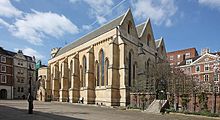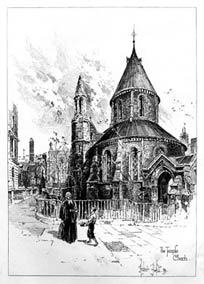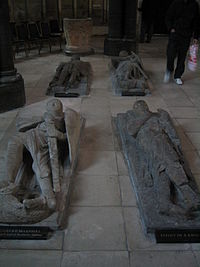Temple Church: Difference between revisions
→Use: Add 2013 photo |
James Vivian now replaced by Roger Sayer as organist and Director of Music |
||
| Line 144: | Line 144: | ||
*Dr [[John Birch (musician)|John Birch]] 1982 - 1997 |
*Dr [[John Birch (musician)|John Birch]] 1982 - 1997 |
||
*[[Stephen Layton]] 1997 - 2006 |
*[[Stephen Layton]] 1997 - 2006 |
||
*[[James Vivian]] 2006 - |
*[[James Vivian]] 2006 - 2013 |
||
*[[Roger Sayer]] 2014- <ref>[http://www.templechurch.com/whos-who/</ref> |
|||
== Master of the Temple == |
== Master of the Temple == |
||
Revision as of 00:54, 5 February 2014
| Temple Church | |
|---|---|
 The Temple Church | |
 | |
| Address | City of London |
| Country | England |
| Denomination | Church of England |
The Temple Church is a late-12th-century church in London located between Fleet Street and the River Thames, built for and by the Knights Templar as their English headquarters. In modern times, two Inns of Court (Inner Temple and Middle Temple) both use the church. It is famous for its effigy tombs and for being a round church. It was heavily damaged during the Second World War but has been largely restored. The area around the Temple Church is known as the Temple and nearby is Temple Bar and Temple tube station.
History
Construction

In the mid 12th century, before the construction of the church, the Knights Templar in London had met at a site in High Holborn in a structure originally established by Hugues de Payens (the site had been historically the location of a Roman temple in Londinium). Because of the rapid growth of the order, by the 1160s the site had become too confined, and the Order purchased the current site for the establishment of a larger monastic complex as their headquarters in England. In addition to the church, the new compound originally contained residences, military training facilities, and recreational grounds for the military brethren and novices, who were not permitted to go into the city without the permission of the Master of the Temple.
The church building comprises two separate sections. The original nave section, called the Round Church, and an adjoining rectangular section, built approximately half a century later, called the Chancel. In keeping with the traditions of the order, the nave of the church was constructed on a round design based on the Church of the Holy Sepulchre in Jerusalem. The nave is 55 feet in diameter, and is surrounded by the first-ever free-standing dark Purbeck Marble columns. It is probable that the walls and grotesque heads were originally painted in colours.
It was consecrated on February 10, 1185[1] in a ceremony by Heraclius, Patriarch of Jerusalem. It is believed that Henry II was present at the consecration.
1185–1307
The Knights Templar order was very powerful in England, with the Master of the Temple sitting in parliament as primus baro (the first baron of the realm). The compound was regularly used as a residence by kings and by legates of the Pope. The Temple also served as an early depository bank, sometimes in defiance of the Crown's wishes to seize the funds of nobles who had entrusted their wealth there. The independence and wealth of the order throughout Europe is considered by most historians to have been the primary cause of its eventual downfall.
In January 1215 William Marshall (who is buried in the nave next to his sons, under one of the 9 marble effigies of medieval knights there) served as a negotiator during a meeting in the Temple between King John and the barons, who demanded that John uphold the rights enshrined in the Coronation Charter of his predecessor Richard I. William swore on behalf of the king that the grievances of the barons would be addressed in the summer, leading to John's signing of Magna Carta in June.
William later became regent during the reign of John's son, Henry III. Henry later expressed a desire to be buried in the church and so, in the early 13th century, the choir of the original church was pulled down and a new larger structure, now called the Chancel, was built. It was consecrated on Ascension Day 1240 and comprises a central aisle and two side aisles of identical width. The height of the vault is 36 feet 3 inches. One of Henry's sons, who died in infancy, is buried in the Chancel, but Henry later altered his will with instructions to be interred in Westminster Abbey.
Crown seizure
After the destruction and abolition of the Knights Templar in 1307, Edward II took control of the church as a Crown possession. It was later given to the Knights Hospitaller, who rented the Temple to two colleges of lawyers. One college moved into the part of the Temple previously used by the Temple's knights, and the other into the part previously used by its priests, and they shared the use of the church. The colleges evolved into the Inner and Middle Temples, two of the four Inns of Court (the other two being Lincoln's Inn and Gray's Inn).
16th–19th centuries

In 1540, the church became the property of The Crown once again when Henry VIII abolished the Knights Hospitaller in England and confiscated their property. Henry provided a priest for the church under the former title "Master of the Temple". In the 1580s, the church was the scene of the Battle of the Pulpits, a theological conflict between the Puritans and supporters of the Elizabethan Compromise. At that time, William Shakespeare also knew it and hence, in his play Henry VI, part 1, it and the Temple garden feature as the setting for the fictional scene of the plucking of two roses and the start of the 15th century Wars of the Roses. In 2002, this was commemorated with the planting of new white and red roses in the modern gardens.
Following an agreement in 1608 by James I, the two Inns were granted the use of the church in perpetuity on condition that they support and maintain it. They continue to use the Temple church as their chapel.
The church was undamaged by the Great Fire of London in 1666. Nevertheless, it was refurbished by Christopher Wren, who made extensive modifications to the interior, including an altar screen and the installation of an organ in the church for the first time. The church was restored in 1841 by Smirke and Burton, who decorated the walls and ceiling in the high Victorian Gothic style in an attempt to bring the church back to its original appearance. Further restoration work was executed by James Piers St Aubyn in 1862.

Second World War
On May 10, 1941, a German air raid of incendiary bombs set the roof of the Round Church on fire,[2] and the fire quickly spread to the nave and chapel. The organ and all the wood parts of the church, including the Victorian renovations, were destroyed and the dark Purbeck marble columns of the Chancel cracked from the intense heat. Although these columns still supported the vault, they were deemed unsound and replaced by replicas. The original columns had a light outward lean, an architectural quirk which was duplicated in the replacement columns.
During the renovation by the architect Walter Godfrey, it was discovered that the renovations made by Wren in the 17th century were in storage and they were replaced in their original position. The church was rededicated in November 1958.[3]
The church was designated a Grade I listed building on 4 January 1950.[4]
Use


Among other purposes, the structure was originally used for Templar initiation ceremonies. In England, the ceremony involved new recruits entering the Temple via the western door at dawn. The initiates would enter the circular nave, and then take monastic vows of piety, chastity, poverty and obedience. The details of initiation at the time were a closely guarded secret, though this secrecy later caused trouble as gossip and rumours spread about possible Templar blasphemy. These suspicions were manipulated and expanded by the Order's enemies, such as King Philip IV of France.
Today the Temple Church holds regular church services, including Holy Communion and Mattins on Sunday morning.[5] It also holds weddings, but only for members of the Inner and Middle Temples. The Temple Church serves both the Inner Temple and the Middle Temple as a private chapel.
The Temple Church has always been a peculiar, and the choristers have the privilege of wearing scarlet cassocks as a result. There is some debate regarding the relationship of its status as Crown Subject and Peculiar. Relations with the Bishop of London are very good and he regularly attends events and services at the Temple Church. The Bishop of London is also ex officio the Dean of the Chapels Royal.

Music at the Temple Church

The church offers regular choral music performances and organ recitals. A choir in the English cathedral tradition was established at the Temple Church in 1842 under the direction of Dr. E. J. Hopkins, and it soon earned a high reputation.[6]
In 1927, the Temple Choir under George Thalben-Ball became world famous with its recording of Mendelssohn's Hear my Prayer, including the solo "O for the Wings of a Dove" sung by Ernest Lough. This became one of the most popular recordings of all time by a church choir, and it sold strongly throughout the twentieth century, reaching gold disc status (a million copies) in 1962 and achieving an estimated 6 million sales to date.
The Temple Church's excellent acoustics have also attracted secular musicians: Sir John Barbirolli recorded a famous performance of the Fantasia on a Theme of Thomas Tallis by Ralph Vaughan Williams there in 1962 (at the suggestion of Bernard Herrmann), and Paul Tortelier made his recording of the complete Bach Cello Suites there in April 1982.
The choir continues to record, broadcast and perform, in addition to its regular services at the Temple Church. It is an all-male choir, consisting of 18 boys who are all educated on generous scholarships (most of the boys attend the City of London School although the scholarship is portable) and 12 professional men. They perform weekly at Sunday services, 11:15-12:15 PM, during term time. The choir gave the world premiere of Sir John Tavener's epic "The Veil of the Temple", which took place over seven hours during an overnight vigil in the Temple Church in 2003. The following year it was performed by the choir at the Lincoln Festival in New York; a concert version was performed at the BBC Proms the same year. Two new recordings were released in 2010 on the Signum Classics label: one of the Temple Church Choir, and a recording of English organ music played by James Vivian. Both were critically acclaimed.
In December 2011, a new recording of the choir on the Signum Classics label will be available from the church (on official release in January 2012). The CD will contain musical settings of the Psalms by Allegri, Bernstein, Byrd, Parry, Purcell and Wesley. For more information, please refer to the official websites below.
Organ
The church contains two organs: a chamber organ built by Robin Jennings in 2001, and a four manual Harrison & Harrison organ, built in 1924 as a private ballroom organ.[7] A current specification of the organ can be found on the Temple Church Choir website.
The Harrison organ will be completely renovated from July 2011 until Easter 2013. It will be removed from the organ chamber and will be thoroughly repaired and cleaned by Harrison & Harrison. A temporary organ has been installed for the duration of the work. For more details of the work or of the Organ Appeal, please visit The Temple Church Choir website.
List of organists
It has had a number of famous organists, including
- Francis Pigott 1688 - 1704
- John Pigott 1704 - 1737 (from 1729 for Middle Temple only)
|
Inner Temple
|
Middle Temple
|
(from 1814 for both Inner and Middle Temple)
- George Price 1814 - 1826
- George Warne 1826 - 1843 (afterwards organist of St Nicholas' Church, Great Yarmouth)
- Dr. Edward John Hopkins 1843 - 1897
- Sir Henry Walford Davies 1897 - 1923
- Sir George Thalben-Ball 1923 - 1982
- Dr John Birch 1982 - 1997
- Stephen Layton 1997 - 2006
- James Vivian 2006 - 2013
- Roger Sayer 2014- [8]
Master of the Temple
The church always has two clergy, called the "Master of the Temple" and the "Reader of the Temple". The title of the Master of the Temple recalls the title of the head of the former order of the Knights Templar. The present Master of the Temple is the Reverend Robin Griffith-Jones, appointed in 1999. The Master gives regular lunchtime talks open to the public.
The official title of the Master of the Temple is the "Reverend and Valiant Master of the Temple";.[9]
List of recent Masters of the Temple
- Rev. Charles John Vaughan 1869-1894
- Rev. Alfred Ainger 1894-1904
- Rev. Henry George Wods 1904-1915
- Rt Rev. Ernest William Barnes 1915-1919
- Rev. Canon Harold Anson 1935-1954
- Rev. Canon John Firth 1954-1957
- Rev. Canon Theodore Milford, MA 1958-1968
- Very Rev. Robert Milburn, MVO 1968-1980
- Rev. Canon Joseph Robinson, BD M.Th FKC 1980-1999
- Rev. Robin Griffith-Jones 1999-
Buried in the church
- Sir Anthony Jackson (1599-1666)
- William Marshal, 1st Earl of Pembroke (1146–1219)
- Robert de Veteripoint, Sheriff of Westmoreland (died 1228)
- William Marshal, 2nd Earl of Pembroke (1190 - 6 April 1231)
- Gilbert Marshal, 4th Earl of Pembroke (1194 - 27 June 1241)
- Sir Edmund Plowden (1518-1585)
- Dr. Richard Mead (1673-1754)
- Francis Rogers (1791–1851)
- James Simpson (1737-1815), Attorney General of Colonial South Carolina. His wife, who predeceased him, is buried in the South Transept of Westminster Abbey.[10]
- Sir John Tremayne (1647–1694)[11]
- Silvester de Everdon
See also
- List of churches and cathedrals of London
- City of London
- Inner Temple
- Middle Temple
- John Selden
- Temple (Paris) - medieval Knights Templar European headquarters.
References
- ^ "The London Encyclopaedia" Hibbert,C;Weinreb,D;Keay,J: London, Pan Macmillan, 1983 (rev 1993,2008) ISBN 978-1-4050-4924-5
- ^ "The Old Churches of London" Cobb,G: London, Batsford, 1942
- ^ "London:the City Churches” Pevsner,N/Bradley,S New Haven, Yale, 1998 ISBN 0-300-09655-0
- ^ Historic England. "Details from listed building database ({{{num}}})". National Heritage List for England. accessed 23 January 2009
- ^ Service Sheet
- ^ Lewer, David (1961). A Spiritual Song, The Story of the Temple Choir & a History of Divine Service in the Temple Church, London, The Templar's Union, ASIN B0014KQ33I
- ^ http://www.npor.org.uk/cgi-bin/NPORSearch.cgi?Fn=HSearch&rec_index=N18094
- ^ [http://www.templechurch.com/whos-who/
- ^ Barnes, John (1979). Ahead of his age: Bishop Barnes of Birmingham. Collins. p. 76. ISBN 0-00-216087-0.
- ^ An exercise in futility: the pre-Revolutionary career and influence of loyalist James Simpson by James Riley Hill, III. M. A. Thesis. University of South Carolina, Columbia, SC, 1992. viii, 109 leaves ; 28 cm. OCLC 30807526
- ^ Handley, Stuart (May 2009). "Tremayne, Sir John (bap. 1647, d. 1694)". Oxford Dictionary of National Biography. Oxford University Press. doi:10.1093/ref:odnb/27692. Retrieved 1 January 2011. (subscription or UK public library membership required)
External links
- Official website of the Temple Church
- Official website detailing the music of the Temple Church
- Middle Temple's website
- Inner Temple's website
- 2008 Temple Festival website
- Temple Church - Sacred Destinations article with large photo gallery
- Black and white images of the Temple - Pitt University
- Ground plan and discussion of round shape - Rosslyn Templars
- The History of the Knights Templar, by Charles Greenstreet Addison, with extensive history and description of Temple Church
51°30′47.52″N 0°06′37.44″W / 51.5132000°N 0.1104000°W
